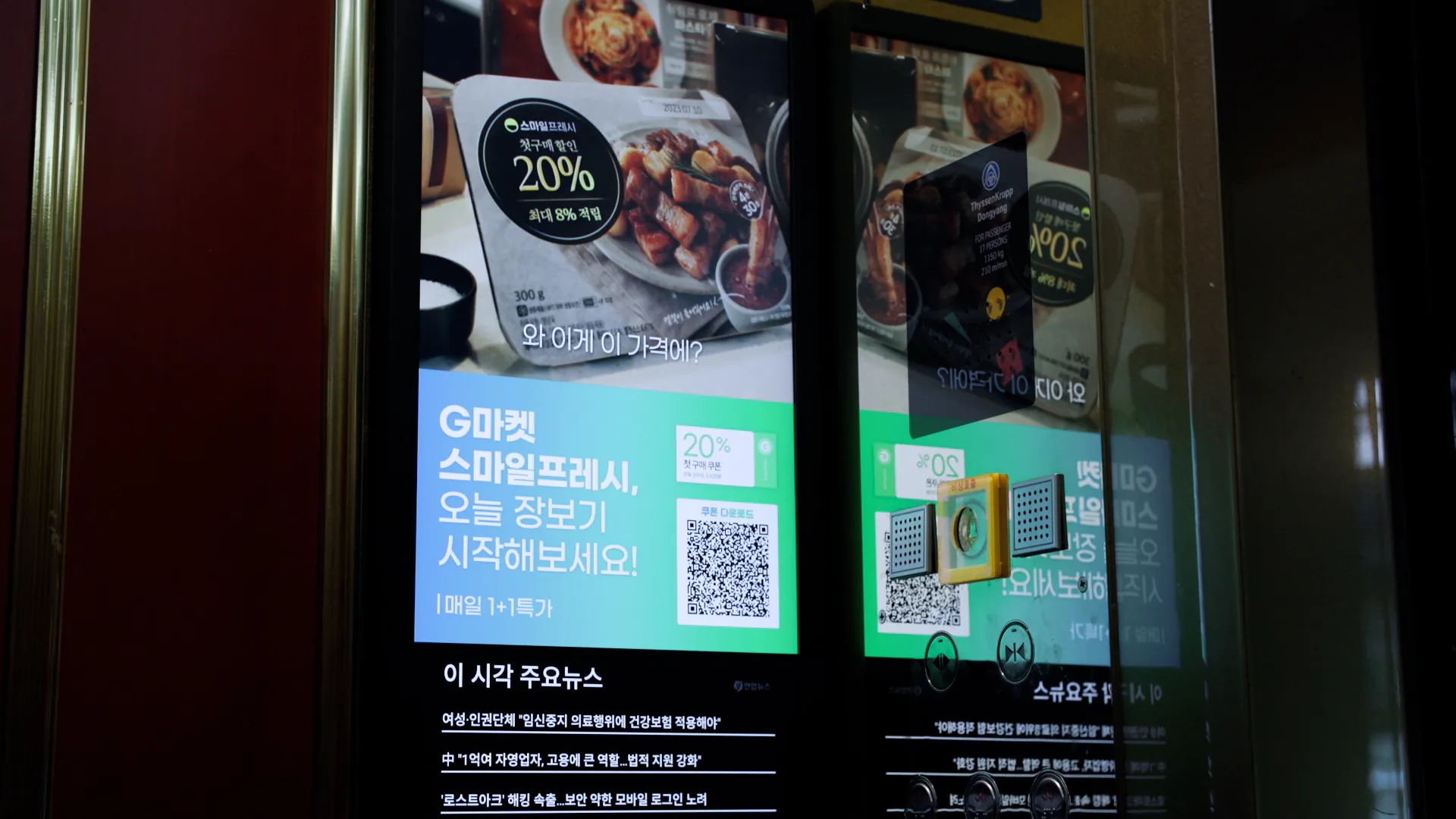What is a Digital Display Board?
Digital display boards can be found everywhere you look nowadays, especially within businesses and public spaces. Everywhere, there are electronic screen displays with vivid images, moving animations, and high-quality videos as advertisements, as well as crucial information or specific instructions for the public. This piece of modern technology has made an impact on people's everyday lives. But what is a digital display board? How can we differentiate it from similar devices, such as television screens or perhaps smart boards?
What is a digital display board or digital board?
A digital display board, also known as digital signage or a digital board, is an electronic display device used to display data, messages, images, videos, text, animations, multimedia elements, or other interactive content. Digital display boards are visual communication tools and solutions that are often found outside businesses, in lobbies, in public spaces, and in retail stores. They are used as an effective way to advertise a product or service, provide navigation, convey information or any announcement, or display location-specific information for visitors.
Businesses across industries have started to consider digital signage solutions, with 60% of enterprises planning to invest in the technology within the next two years. Meanwhile, those who are already using digital display boards report an increase in sales of up to 33%, with sales leaning more toward luxurious purchases than planned purchases.
Digital display boards are highly customizable, allowing for different layouts, colors, and fonts; and some models even feature video capability. Digital signage like this also comes in various sizes, shapes, and formats. They can range from small screens in public transportation to large video walls in shopping malls, stadiums, or corporate offices. They can also be connected to the internet or be used stand-alone, so the content can be easily updated and changed for maximum usefulness.
What are the benefits of digital display boards?
Digital display boards are powerful and versatile solutions for different kinds of businesses and establishments. Here are some of the benefits of using digital display boards:
They display dynamic content
Unlike traditional static signage, digital displays allow for dynamic content that can be easily updated and changed remotely. This flexibility enables real-time communication and customization. This kind of versatility also widens the communication scope and provides a more personalized experience for users or viewers.
They foster engagement
Sixty-four percent of those who use digital signage report that increased customer engagement is its main benefit. The dynamic nature of digital displays tends to capture more attention than static displays. The ability to incorporate motion, animation, and interactive elements enhances audience engagement. This helps build a stronger connection with the audience and creates a better atmosphere for captivating visuals.
They can be used for targeted messaging
Digital displays can be programmed to display specific content at certain times or in response to certain triggers, enabling targeted messaging for specific audiences. This allows for a wider and better reach to the people who need certain messages the most.
They are cost-effective and sustainable in the long run
While initial setup costs might be higher compared to traditional signage, digital displays can ultimately save money over time by eliminating the need for printing and distribution of static materials. A digital signage solution is also more sustainable since every page printed with a laser printer produces approximately one (1) gram of carbon dioxide.
They are flexible
Content on digital displays can be changed quickly and easily, allowing for rapid response to changing circumstances, promotions, or events. This kind of flexibility allows businesses or establishments to tailor the digital display perfectly to their needs.
Some offer analytics
Some digital display systems offer analytics and metrics to track viewer engagement and gather insights about the effectiveness of the displayed content. This data can also be utilized to determine how it can be modified for additional improvements. This can help in the decision-making process and marketing strategies.
They can be used to display multimedia feeds
Digital displays can incorporate various types of multimedia content, including videos, images, text, and live data feeds. With the right combination of multimedia elements, digital display boards can capture attention, engage viewers, and communicate ideas in an impactful way.
What is the use of a digital display board?
Digital display boards can be found in various environments and industries for various purposes. This includes public spaces, retail settings, educational institutions, healthcare facilities, hotels, industrial buildings, residential complexes, transportation hubs, and various other settings where information dissemination and advertising are important.
A digital display board has the flexibility, dynamic content capabilities, and ability to engage audiences to make it a versatile tool for communication. Here are some common uses of digital display boards:
- Advertising and Promotion: Digital display boards or digital signage are often used to advertise products, services, promotions, upcoming events, and special offers. Their dynamic nature and ability to showcase videos and animations make them more attention-grabbing or eye-catching compared to traditional static signage or printed materials.
- Information or Announcement Dissemination: These digital boards are commonly used to provide information to the public or specific target audiences. This could include news updates, event schedules, directions, safety information, and more.
- Wayfinding Navigation: When it comes to large venues like malls, arenas, airports, and hospitals, as well as transportation hubs or platforms, digital display boards can help people navigate through the space. They provide interactive maps, directions, and various points of interest for visitors or consumers.
- Corporate Communication: Within corporate environments, digital display boards are used to communicate internal announcements, company news and achievements, employee recognition, and important updates to staff members and office employees. Digital signage enhances internal communication, which then leads to 25% higher employee productivity.
- Menu Boards: In restaurants, cafes, fast-food chains, and other dining establishments, digital menu boards allow for easy updating of menu items, prices, and promotions. They can also display images and videos of the dishes to entice customers. Of course, they can also be used to advertise dining events, buffets, happy hours, and more.
- Entertainment: Digital display boards are often seen at entertainment venues to display upcoming shows, movie trailers, live event updates, and interactive games to engage the audience. They can also be used to entertain people in lobbies, lounges, waiting areas, elevators, and more.
- Education: Educational institutions use digital signage to communicate announcements, event details, class schedules, emergency information, and other campus news to both students and faculty. In fact, 73% of learning institutions agree that the benefits of digital signage in education are crucial for the future of communication.
- Public Transportation: In transportation hubs like bus stations, train stations, and airports, digital displays provide real-time information about arrivals, departures, delays, and routes.
- Healthcare Facilities: Hospitals and clinics can use digital display boards to communicate patient information, appointment schedules, health tips, pandemic guidelines, and other important notices.
- Retail Settings: Retail stores use digital displays to showcase product features, customer reviews, and sales information. These displays can also create an immersive shopping experience through interactive features, picking or wayfinding features, and more.
- Real-Time Data Display: In financial institutions like banks, insurance companies, investment companies, credit unions, stock markets, and other settings, digital display boards can show real-time financial data. This includes stock prices, cryptocurrency prices, exchange rates, and other financial information crucial to the industry.
- Event Promotion: Digital displays are used to promote upcoming events, conferences, exhibitions, and trade shows. They showcase event details and highlights for all to see and read.
- Hotel and Hospitality: Hotels, on the other hand, use digital displays to welcome guests, provide information about amenities and services, display event schedules, and promote in-house services.
- Interactive Engagement: Some digital display boards incorporate touch- or gesture-based interactivity, allowing users to interact with the content. This is often used in museums, interactive kiosks, and a few retail settings.
- Brand Enhancement: Digital display boards can reinforce a brand's image and message. This is done by displaying consistent and visually appealing content throughout the establishment.
What is the difference between a digital display and a TV?
A "digital display" and a "TV" (television) both involve displaying visual content, but they serve different purposes and have distinct features. Here's a quick comparison between the two:
Key Characteristics of Digital Displays:
- Purpose and Usage: Digital displays are often used for commercial, informational, or professional purposes. They can be found in public spaces, retail stores, corporate environments, educational institutions, transportation hubs, and more.
- Content Flexibility: Digital displays can show a variety of digital content, including images, videos, presentations, animations, live data feeds, and interactive elements.
- Customization: Content on digital displays can be easily customized and updated remotely, allowing for dynamic and real-time communication.
- Forms and Variations: Digital displays come in various forms, including standalone screens, video walls (large displays made up of multiple screens), and interactive touchscreens.
- Connectivity: They often provide a range of connectivity options to connect various devices and sources, such as computers, media players, cameras, and more.
- Functionality: While some digital displays have interactive capabilities, not all of them offer touch-sensitive interactions like smartboards or touchscreens.
Key Characteristics of Televisions:
- Home Entertainment: TVs are primarily intended for personal entertainment in homes and private settings. They are used for watching TV shows, movies, streaming content, gaming, and more.
- Broadcast Reception: TVs include tuners to receive over-the-air broadcast signals or cable or satellite signals for watching television channels.
- Remote Control: TVs come with remote controls that allow users to change channels, adjust volume, and navigate menus.
- Audio: TVs often have built-in speakers to provide sound along with the visual content.
- Streaming and Connectivity: Modern TVs offer smart features, allowing access to online streaming services, apps, and internet browsing.
- Size and Display Quality: TVs are available in various sizes and resolutions, with a focus on providing high-quality visuals and a comfortable viewing experience.
What is the difference between a digital board and a smart board?
A "digital board" and a "smart board" are terms often used interchangeably. However, they refer to slightly different concepts. They are related in the context of modern technology and education, yes, but both of these display solutions have their own differences.
Digital Board:
A digital board generally refers to a display or surface that can display digital content, such as images, videos, and presentations in various public settings. It can be a standalone digital screen, a monitor, or even a projector screen. The term "digital board" emphasizes the capability to show digital information rather than traditional physical materials like printed materials, chalkboards, or whiteboards.
Smart Board (Interactive Whiteboard):
A smart board, on the other hand, specifically refers to an interactive, digital whiteboard that combines a physical board-like surface with digital technology. It is a touch-sensitive interactive display that can be written on using a special stylus or even a finger. The key feature of a smart board is its interactivity and connectivity. It allows users to interact with the displayed content in real time, and it can usually connect to a computer, laptop, or projector. These smart boards are often used in educational settings and collaborative environments for learning purposes.
SOLUM Digital Signage as a Digital Display Board Solution
SOLUM Group has brought cutting-edge technology for businesses or establishments that want to use digital display boards. SOLUM Digital Signage is a dynamic and high-powered visual solution for those who want to advertise their business and show crucial and helpful information to customers every day. SOLUM Digital Signage comes in three variations: the 50-inch monitor, the 29-inch touch screen, and the 11.6-inch ESL with Aims Link.
Here are some of its benefits and features:
- High visibility
- High utilization
- Additional advertisement profit
- CMS Integration
- Content editing and management
- Content report
- Automatic run of advertising images and delivery of information
- Bulletin board functionality
- Customizable screen display
- Commercialization
- Real-time data collection and analysis
- Touch screen (29-inch) to foster customer engagement
- Eco-friendly
- Minimal maintenance cost
- Small and compact for space utilization (11.6-inch ESL)
No matter what angle you look at it, a digital display board has a lot of potential and is an avenue for all kinds of businesses to grow and provide the best service to people. If you're looking for the ideal digital display board solution for your business, talk to SOLUM experts today to get started.











